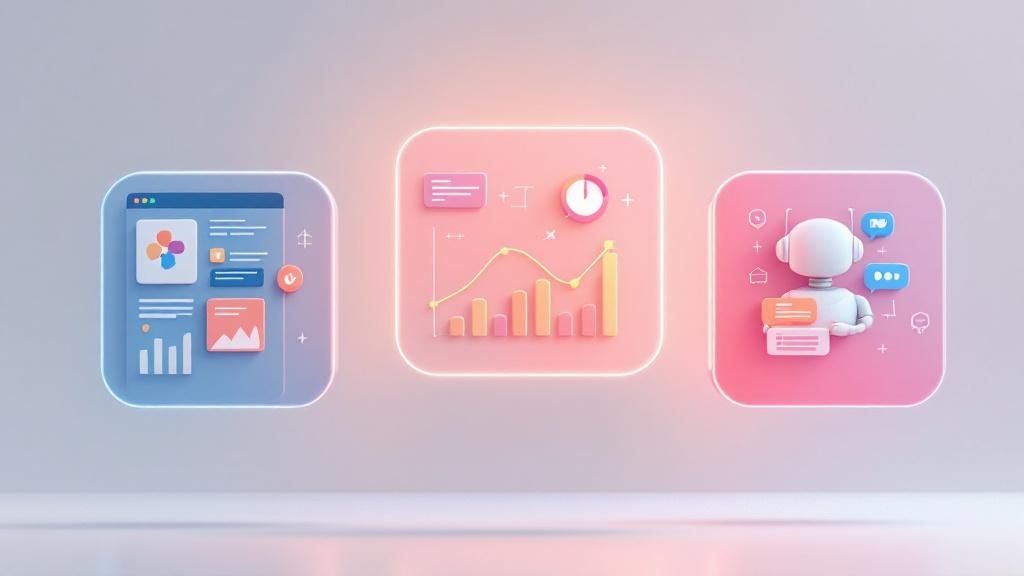Think of all the ways a customer can get in touch with you these days. Emails, phone calls, live chat, maybe a message on social media… it’s a lot to keep track of. A customer interaction management solution is designed to pull all of those conversations together, giving your entire team a single, unified view of every single interaction.
It's your command centre for customer communication.
What Is Customer Interaction Management?

Imagine trying to run an airport without an air traffic control tower. It would be chaos. Pilots would have bits and pieces of information, leading to crossed wires, frustrating delays, and maybe even a disaster. That’s pretty much what it’s like trying to manage customer relationships without a proper system in place.
That’s where customer interaction management solutions come in. They act as that crucial control tower for your business.
Every touchpoint is collected and organised into one clear timeline. This means a support agent can see a customer's purchase history from the sales team, and a salesperson knows about their recent social media comment. This shared context gets rid of that all-too-common frustration where a customer has to repeat their story over and over again to different people in your company.
Creating a Single Source of Truth
The whole point is to create a single source of truth. Instead of customer information being siloed away in separate inboxes, phone logs, or social media accounts, it’s all right there in one place for everyone to see. This empowers your teams to deliver service that’s consistent, personal, and way more efficient.
So, how do modern platforms pull all this off? They integrate all the different ways customers talk to you. Below is a quick look at the core components that make these systems tick.
Core Components of a Modern Interaction Management Solution
| Component | Primary Function |
|---|---|
| Voice & Call Management | Transcribes and analyses phone calls for sentiment, keywords, and key topics. |
| Email Integration | Automatically logs and organises all email threads related to a customer or case. |
| Live Chat & Messaging | Captures real-time digital conversations from your website or apps like WhatsApp. |
| Social Media Monitoring | Tracks brand mentions, comments, and direct messages across social platforms. |
| Centralised Database | Creates a single, unified profile for each customer, holding their entire interaction history. |
| AI & Automation Engine | Analyses data, identifies trends, and automates routine tasks to boost efficiency. |
These components work together to ensure no conversation falls through the cracks, giving you a complete picture of every customer relationship.
The Role of Automation and AI
But these systems do more than just collect data. The real magic happens when artificial intelligence gets involved. Modern solutions use AI to turn all that raw conversation data into something genuinely useful. This often involves robust customer support automation, where smart assistants help your team work faster and more effectively.
An effective interaction management platform doesn’t just store data; it makes that data intelligent. It can identify trends, flag at-risk customers, and even suggest the next best action for a support agent to take.
This technology is a big reason why the market is growing so quickly. Here in Australia, the demand for these systems is booming. The market was valued at USD 1.97 billion and is expected to hit USD 5.01 billion by 2033. This growth is being driven by businesses realising the power of AI and predictive analytics to completely change how they manage their customer relationships.
The Business Impact of Centralized Interactions

Bringing in a customer interaction management solution is more than just a neat way to organise data. It’s a genuine strategic shift. When all your customer conversations are in one spot, you move from a scattered, reactive mess to a proactive, unified approach that actually hits your bottom line.
The first thing you’ll notice is a massive leap in the customer experience. Think about it: when your team can see a complete history of every chat, email, or call, customers don't have to repeat their life story every time they get in touch. That simple change turns what could be a frustrating exchange into a smooth, helpful conversation that makes people feel properly looked after.
This all-in-one view is also your ticket to true personalisation. Forget generic, copy-paste replies. Your team can tailor their communication based on what a customer has bought before, their past support tickets, or even a casual question they asked last week. That's the kind of service that turns a one-off buyer into someone who raves about your brand to their mates.
Boosting Team Efficiency and Focus
Centralised interactions don't just help customers; they unlock some serious wins for your team's efficiency. By automating the boring stuff like logging calls or sorting emails, these platforms free up your crew from soul-crushing admin work. This lets them get back to what they do best: solving tricky problems and building real relationships with customers.
It's like giving your team a superpower. Instead of digging through three different systems to find one piece of information, they have everything they need right there. Issues get sorted faster and more effectively, which doesn't just boost productivity—it makes for a happier team, too.
Take a look at the Aussie retail scene, where a 9.2% jump in spending has pushed businesses to adopt these kinds of tools. With retail spending hitting around USD 242 billion, companies are using centralised platforms to get a clearer picture of their customers and provide the quick, responsive service needed to stay ahead. You can read more about how technology is shaping Australian retail on expertmarketresearch.com.
Driving Smarter Business Decisions
Finally, a solid customer interaction platform is an absolute goldmine of business intelligence. When you can analyse conversations from every channel, you start to uncover killer insights that can shape your whole strategy.
You get a crystal-clear picture of:
- Customer Pain Points: Spot the recurring issues that are tripping up your customers.
- Emerging Trends: Pick up on new questions or topics that signal a shift in what the market wants.
- Performance Gaps: See where your team is knocking it out of the park and where a bit of extra training could help.
These data-driven insights let you make smarter, more proactive decisions. You can fine-tune your products, sharpen up your processes, and ultimately build a stronger, more customer-focused business that leaves the competition in the dust.
The Core Capabilities of a Modern Platform
A modern customer interaction management solution is so much more than a digital address book. Think of it as a dynamic engine, built to orchestrate conversations and uncover the kind of insights that truly move a business forward. It's not just about storing information; it's about actively managing the flow of communication.
The absolute foundation of any good system is omnichannel communication. Picture this: a customer starts a chat on your website, sends a follow-up email a few days later, and then calls your support line the next week. An omnichannel platform sees this as one continuous conversation, not three separate incidents. This means the agent on the phone can instantly see the entire history, so the customer never has to repeat themselves. It’s this seamless, unified approach that defines modern customer service.
Powering Efficiency with Smart Automation
Beyond just bringing all your channels together, these platforms inject powerful automation to take care of the repetitive, time-sucking tasks. This is where things get really interesting.
Contact centre automation, for example, is a total game-changer. It uses intelligent routing to send incoming calls or messages to the perfect agent based on their skills, availability, or even the customer's past interactions. A complex technical query? It goes straight to your senior support specialist. A new sales lead? It lands directly with the sales team. No more manual transfers or wasted time.
Then you have AI-powered chatbots. These bots are your 24/7 frontline support, handling common questions and gathering initial details before handing off to a human agent. This frees up your team to focus on the more complex, high-value conversations that genuinely require a human touch.
Uncovering Hidden Gems with AI-Driven Analytics
Perhaps the most powerful piece of the puzzle is AI-driven analytics. Modern platforms don't just record conversations; they actually understand them. Every call can be automatically transcribed and analysed for keywords, customer sentiment, and emerging patterns.
This transforms your customer conversations from simple records into a rich source of business intelligence. You can pinpoint recurring customer pain points, identify coaching opportunities for your team, and spot dissatisfaction before it escalates into a major issue.
This area is exploding right now, especially in the Australian market. Customer communication management (CCM) software, a key part of these solutions, is projected to grow at a CAGR of 15.9% from a market currently valued at USD 56.7 million. This growth is being driven by heavy investment in tools that improve communication, with around 37% of Australian contact centres now using AI to lift their customer experience game. You can explore the full findings on the CCM software market on grandviewresearch.com.
To put the shift into perspective, let's compare the old way of doing things with the new, AI-powered approach.
Comparing Traditional vs AI-Powered Interaction Management
| Feature Area | Traditional Approach | AI-Powered Approach |
|---|---|---|
| Call Routing | Manual transfers or basic rules (e.g., next available agent). | Intelligent routing based on agent skill, customer history, and sentiment. |
| Data Analysis | Manual review of call logs and customer surveys. Slow and often biased. | Real-time transcription and sentiment analysis across all channels. |
| Agent Support | Relies on manager listening in or post-call coaching. | AI provides real-time suggestions and knowledge base prompts to agents during calls. |
| Reporting | Basic metrics like call volume and duration. | Deep insights into conversation topics, customer pain points, and agent performance. |
| Self-Service | Simple IVR menus ("Press 1 for sales…"). | Conversational AI chatbots that can resolve complex issues 24/7. |
The difference is clear. While traditional systems simply record what happened, AI-powered platforms actively help you understand why it happened and what you can do about it.
Workflow Automation and Seamless Integrations
Finally, a top-tier platform has to play nicely with the other tools your business depends on. This isn’t just about convenience; it's about building a connected ecosystem where data flows freely between your systems, like your CRM, e-commerce platform, or marketing software.

As the data shows, a tight, well-planned integration drastically reduces setup time and improves data accuracy. This is why choosing the right call management software with robust integration capabilities is so critical for long-term success. It ensures your customer interaction data makes every other part of your business smarter.
Getting Your New Solution Up and Running

Bringing in new tech can feel like a huge job, but getting your customer interaction management solution rolled out successfully all comes down to a clear, strategic game plan. It’s not about just flipping a switch; it’s about laying a solid groundwork so the platform starts adding real value from day one.
The real work actually starts way before you even pick a vendor. First up, you need to define what a "win" looks like for your business. Are you trying to slash customer wait times, solve more issues on the first call, or get a better read on how your customers are feeling? Nailing down these specific goals is absolutely crucial.
When you know exactly what your pain points are, you can pick a solution that tackles them head-on, instead of just grabbing a tool with a bunch of fancy features you'll probably never touch.
Choosing the Right Partner and Platform
Once you’ve got your objectives sorted, picking a vendor becomes a whole lot easier. Don't just get dazzled by a list of features; you need to suss out the provider as a long-term partner. A great platform should be able to grow alongside your business, so scalability isn't just a nice-to-have, it's a must.
You also have to think about how well it plays with your other tools. A solution that can’t link up smoothly with your existing CRM or marketing software is going to cause more headaches than it solves. It’s vital to make sure the platform can slot into a connected operational ecosystem. To get a better feel for what to look for, checking out different call management solutions can give you some great context on integration and scalability.
Choosing a vendor is like hiring a key team member. You need to assess their reliability, support structure, and commitment to your success, not just their resume of features.
Finally, think about what comes after the purchase. A smooth transition needs some serious planning around migrating data, setting up the system, and, most importantly, getting your team properly trained.
Setting Your Team Up for Success
Let's be honest, the biggest hurdle with any new tech is getting people to actually use it. A powerful platform is pretty useless if your team doesn't get on board. To sidestep this common trap, make sure your training is all about how the solution makes their jobs easier, not just a boring tutorial on which buttons to click.
Here’s a simple roadmap to get everyone on board:
- Start with Champions: Find a small group of keen team members to pilot the software. Their success stories and positive feedback will create a buzz across the whole organisation.
- Provide Role-Specific Training: Show your sales team how it helps them close deals faster. For your support agents, demonstrate how it cuts down their admin workload. Make it relevant to them.
- Establish Clear Processes: Write down the new workflows and best practices so everyone is using the system consistently and effectively right from the get-go.
By following this strategic playbook, you can dodge the usual implementation headaches and make sure your investment starts paying off straight away.
Maximising Your Platform's Long-Term Value
Getting your new customer interaction management solution up and running is a huge win, but it’s really just the starting line. The real magic happens when you treat the platform as a living, breathing part of your business—one that needs a bit of ongoing attention to keep delivering the goods.
Long-term success really boils down to maintaining a single source of truth for all your customer data. When that information is spot-on, every single department, from sales to support, can make smarter, faster decisions. This means you need solid data hygiene practices right from day one to stop duplicate entries and outdated info from muddying the waters.
Empowering Your Team Beyond Basic Training
Initial training gets everyone on the same page, but continuous development is what turns a regular user into an absolute powerhouse. Your team needs to understand not just how to use the software, but why it matters. It's not just another admin tool; it’s their secret weapon for delivering standout service.
This means coaching them on how to dig into the platform’s deeper insights. For instance:
- For Sales: Show them how to use interaction histories to make their outreach incredibly personal and even predict what a customer might need next.
- For Support: Teach them to analyse past chats and calls to find the root cause of a problem, not just apply a quick fix.
When your team sees how the platform directly helps them nail their targets and make customers happier, their buy-in and engagement will go through the roof.
The goal here is to build a culture of constant improvement. You want your team actively hunting for ways to use the platform's insights to make everything they do—and the customer's journey—that much better.
Turning Analytics into Action
Your customer interaction management solution is an absolute goldmine of data. If you're serious about growth, you can't just let that data sit there. You’ve got to get in the habit of regularly reviewing your analytics to spot trends, check how you’re tracking against your goals, and uncover new opportunities.
A quick, consistent look at your analytics dashboard can show you patterns you’d completely miss otherwise. You might spot a sudden spike in questions about a new feature, which tells you the help docs need a rewrite. Or you might find your top-performing agents all use a specific phrase that you can then teach to the rest of the team. It’s all there, waiting to be found.
Creating a Connected Ecosystem
Finally, getting the most value long-term means integrating your platform deeply with your other business systems. Your interaction tool shouldn't be off on its own little island. When you connect it to your CRM, marketing automation tools, and e-commerce platform, you create a seriously powerful, unified system.
This setup lets data flow seamlessly between departments, giving everyone a complete, up-to-the-minute picture of every customer. That 360-degree view is what allows you to deliver the kind of smart, joined-up experiences that build real loyalty and drive proper, sustainable growth.
Where Customer Interaction is Heading Next
The way we interact with customers is changing fast, and it’s moving way beyond just answering questions as they come in. The future is all about being proactive, predictive, and incredibly personal. We’re stepping into an age of hyper-personalisation, where smart customer interaction management solutions use AI to figure out what a customer needs before they even ask.
Imagine a system that spots a potential problem based on how a customer is using your product and reaches out with a solution before they even notice something's wrong. That’s the big shift from reactive support to preventative service, and it's all powered by predictive analytics. This new approach cuts down on customer frustration and builds serious brand loyalty by solving problems before they even become problems.
The next big thing isn't just about answering faster; it's about making every interaction so smooth and intelligent that it feels like a genuine conversation, not just another support ticket.
Generative AI is also about to become a major player here. Think dynamic, human-like responses that stay perfectly on-brand across every single channel, every single time. As businesses gear up for these changes, features like the intelligent call routing you find in modern platforms are already laying the groundwork. This tech makes sure that even as the systems behind the scenes get more sophisticated, the customer's journey stays simple, efficient, and perfectly in sync.
Got Questions? We’ve Got Answers.
Jumping into the world of customer interaction management can feel a bit full-on, so it’s only natural to have a few questions. Let's clear up some of the most common ones we hear from businesses just like yours.
How Is This Different from a Standard CRM?
Good question. Think of your CRM like a digital filing cabinet or a detailed address book. It’s brilliant at storing customer information – their contact details, purchase history, and key notes. It’s the ‘who’ and the ‘what’.
A customer interaction management solution, on the other hand, is the live switchboard operator. It’s what actually manages the conversations as they happen, across every channel, from phone calls to emails and chats. It works hand-in-glove with your CRM, feeding it real-time context to make every touchpoint smarter. It’s the ‘how’ and the ‘why’ of every customer chat.
Is This Technology a Good Fit for a Small Business?
Absolutely. The days when this sort of powerful tech was reserved for the big end of town are long gone. Modern, cloud-based solutions are built to be affordable and scalable, making them a perfect match for small and medium-sized businesses.
For an SME, delivering a top-notch customer experience isn’t just a nice-to-have; it’s a massive competitive advantage. These platforms level the playing field, giving smaller teams the tools to provide the kind of personal, responsive service that builds serious loyalty.
The biggest mistake we see is business owners thinking they're "too small" for a proper interaction management system. The reality is, it's often the very tool that helps a small business punch well above its weight and grow faster.
What’s the Biggest Hurdle When Getting Started?
You might be surprised to hear that the most common challenge isn't technical at all—it's getting the team on board. You can have the most advanced platform in the world, but if your crew doesn't use it, it’s just expensive shelfware.
The secret to success is showing your team how the new system makes their job easier, not harder. Focus on clear, role-specific training and maybe start with a small pilot group. These first users often become your biggest advocates, building momentum and helping get everyone else excited about the change.
Ready to stop juggling calls and start managing customer interactions with intelligence? See how OnSilent can give you back hours every week and make sure no important conversation ever slips through the cracks. Find out more at https://onsilent.com.

